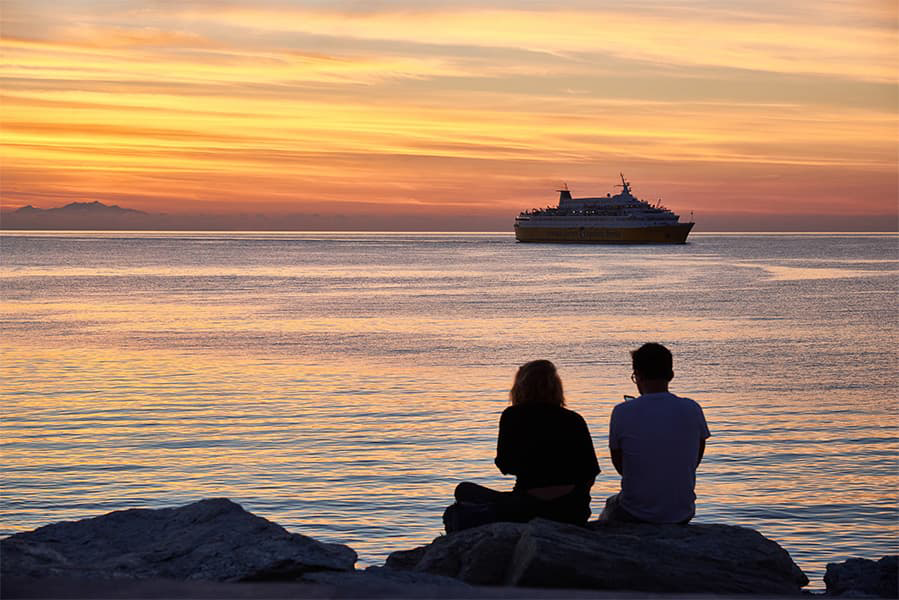Denia – Ibiza
Ferry to Ibiza
Denia – Ibiza
Ferry to Ibiza

Depending on the season their are about 10 weekly sailings between Denia and Ibiza.Balearia provides the ferry from Denia to Ibiza. Denia Ibiza ferries take around 2 hours 15 minutes. The ferry costs between $311.32 and $1,631.31, depending on ticket details. Prices exclude any service fees. Ferry timetables change seasonally, use our Deal Finder to get live pricing and availability for ferries from Denia to Ibiza.
The earliest Denia Ibiza ferry typically departs Denia at about 08:30 and the last ferry usually leaves at 17:00.
Ferries from Denia to Ibiza sail in around 2 hours 15 minutes. The fastest ferry is approximately 2 hours 15 minutes. Ferry duration can vary by ferry provider and can be impacted by weather conditions.
There is 10 weekly sailings from Denia to Ibiza provided by Balearia. Timetables can change from season to season.
The price of a ferry from Denia to Ibiza typically range between $311.32* and $1,631.31*. On average the Denia Ibiza ferry is $851.03*. The cheapest Denia Ibiza ferry prices start from $311.32*. The average price for a foot passenger is $602.02*. The average price for a car is $1,016.47*.
Pricing will vary depending on number of passengers, vehicle type, route and sailing times. Pricing is taken from searches over last 30 days and exclusive of service fees, last updated 1 April 2025.
The distance between Denia to Ibiza is approximately 91 miles (147km) or 79 nautical miles.
Yes, Denia Ibiza ferries allow cars onboard with Balearia between Denia and Ibiza. To view car ferry tickets and prices between Denia and Ibiza use our Deal Finder.
Balearia allow foot passengers on Denia Ibiza ferries.
Balearia allow pets on ferries from Denia to Ibiza. Please also note that your pet may have to stay in the vehicle during the journey.
More routes than anyone else.

Compare fares, times & routes in one place.
Change plans easily with flexi tickets.

Book e-tickets & manage trips in-app.
Live ship tracking & real-time updates.

Top-rated customer support when you need it.
The Spanish city of Denia is situated in the Alicante region of Spain, on the Costa Blanca around half way between Alicante and Valencia. Denia is quite close to the town of Xabia and lies on the Mediterranean Sea coast. it is opposite the Balearic Islands and has the impressive mountains of the Montgo Natural Park as a backdrop. Providing excellent views of the city, the surrounding area and the sea is the town's 11th and 12th century castle which overlooks the town. Within the castle is the Palau del Governador, the castle's museum. The town is host to a number of festivals but is perhaps best known for the running of the bulls fiesta which takes place each July and has been declared as being of National Tourist Interest.
The town's beaches are wide and great for watersports and tend to have been awarded the European Blue Flag for water quality and clean sand. Located to the north of Denia visitors will find the fine sandy beaches of Les Marines. To the south of the town is the rocky area of Les Rotes which has spectacular coves and crystal clear waters which make it the perfect location for snorkelling or scuba diving.
From the city's port visitors are able to catch ferries to the Balearic Islands which depart on a daily basis.
The Spanish island of Ibiza lies in the Mediterranean Sea and is located to the east of the Iberian Peninsular and is one of the Balearic Islands. The island's land area is just over 570 sq. km and along with the neighbouring island of Formentera was called the island of the pines by the Greeks. Ibiza Town, the largest town on the island, was first settled by the Phoenicians and still has walls surrounding it that were built in the 16th century to prevent attack by Turkish pirates.
Today, the town is characterized by narrow cobbled streets, medieval mansions and a cathedral which is located close to the castle. the island is popular with scuba divers who are attracted to the island's warm, clear waters. The sea bed in the Las Salinas National Park is a UNESCO World Heritage Site, because of the ecological importance of the sea grass that grows there.